 |
 |
 |
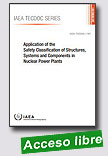 |
Application of the Safety Classification of Structures, Systems and Components in Nuclear Power Plants
IAEA TECDOC, 2016, 76 p.
This TECDOC aims at assisting any organization in establishing a comprehensive safety classification of SSCs compliant with the IAEA recommendations.
Guidance is provided to capture all SSCs to be classified and to assign each of them to the appropriate safety class to reflect its own safety significance.
To establish a comprehensive and consistent classification
|
this TECDOC indicates the inputs for starting the classification and the different steps to be accomplished. It also provides further information and examples to assist with the understanding of the guidance already provided by the Safety Guide SSG-30.
Extraído de:
http://www-pub.iaea.org/books/IAEABooks/10973/
Application-of-the-Safety-Classification-of-
Structures-Systems-and-Components-in-Nuclear |
 |
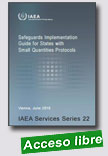 |
Safeguards Implementation Guide for States with Small Quantities Protocols
IAEA Services Series, 2016, 97 p.
This publication is aimed at States with very limited quantities of nuclear material, which have Small Quantities Protocols to their comprehensive safeguards agreements with the IAEA. It explains the safeguards activities carried out in these States, and provides forms and instructions for completing them. It is primarily intended for individuals responsible for safeguards implementation. Recognizing that they often have other |
responsibilities such as radiation safety and security, the Guide highlights some possibilities for synergies among these disciplines. (This version is the 2016 update.)
Extraído de: http://www-pub.iaea.org/books/IAEABooks/10493/Safeguards-Implementation-Guide-for-States-with-Small-Quantities-Protocol
|
 |
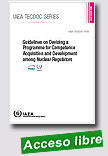 |
Guidelines on Devising a Programme for Competence Acquisition and Development among Nuclear Regulators
IAEA TECDOC, 2016, 141 p.
This publication provides the outline of a programme to strengthen regulatory competences, based on the operating experience of countries with a developed nuclear programme and which are members of the Forum of Radiological and Nuclear Regulatory Agencies (FORO). The guidelines are designed to optimize the resources of the Ibero-American .
|
region and they complement and supplement the IAEA’s Safety Reports Series No. 79 as a frame of reference
Extraído de: http://www-pub.iaea.org/books/IAEABooks/11161/Guidelines-on-Devising-a-Programme-for-Competence-Acquisition-and-Development-among-Nuclear-Regulators
|
 |
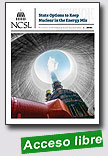 |
|
Since 2013, six nuclear reactors have permanently closed in California, Florida, Nebraska, Vermont and Wisconsin. Operators have announced that eight additional reactors in Illinois, Massachusetts, Michigan, Nebraska, New York and New Jersey could close by 2019, while two reactors at a plant in California will be shut down by 2025.
The U.S. has 99 operating nuclear reactors in 30 states. They provide about 20 percent of the nation’s electricity and approximately 60 percent of its carbon-free generation.
Competition from other energy sources and little growth in electricity demand, however, have caused a number of nuclear plants to struggle in wholesale electricity markets.
State legislatures play a critical role in determining the future of U.S. nuclear power. At least 21 states are considering measures to support the continued use of nuclear generation in recent legislative sessions. In the final months of 2016, Illinois and New York took action to prevent the premature closure of several nuclear plants, but across the country, challenges remain.
To raise awareness and foster dialogue, NCSL has published a comprehensive report, “State Options to Keep Nuclear in the Mix,” which provides background on the state of U.S. nuclear facilities and discusses policies, trends and market conditions that have led to the current environment.
The report also provides an overview of nuclear-related state action and policy options for legislators who are interested in preserving nuclear assets in their state.
These range from offering tax incentives to the creation of statewide nuclear mandates and clean energy subsidy payments. These policy options come in a variety of forms, many of which have already been proposed and discussed in various states.
This report is intended to continue the conversation on the role of state policymakers, utility regulators, federal officials and the nuclear industry in providing affordable, reliable and clean energy across the U.S.
Extraído de: http://www.ncsl.org/blog/2017/01/26/state-options-to-keep-nuclear-power-in-the-energy-mix.aspx
|
 |
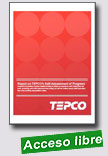 |
Report on TEPCO´s Self-Assessment of Progress
Tokyo Electric Power Company(TEPCO), 2017, 21 p.
Since the 2011 accident at Fukushima Daiichi, TEPCO has been moving on two fronts: (1) Decommissioning and decontaminating Fukushima Daiichi through the Fukushima D&D Engineering Company, and (2) implementing an overall Nuclear Safety Reform Plan, which extends to all three nuclear power stations and throughout the company´s management.
Although the company provides regular quarterly progress reports to the independent Nuclear Reform Monitoring
|
Committee overseeing these activities and publishes them, as the three-year anniversary of Plant´s adoption was reached, it was decided that a thorough self-assessment would be useful.
Extraído de: http://www.nrmc.jp/en/report/detail/__icsFiles/afieldfile/2017/02/02/1E.pdf
|
 |
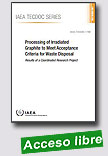
|
Processing of Irradiated Graphite to Meet Acceptance Criteria for Waste Disposal
IAEA TECDOC, 2016, 150 p.
Graphite is widely used in the nuclear industry and in research facilities and this has led to increasing amounts of irradiated graphite residing in temporary storage facilities pending disposal. This publication arises from a coordinated research project (CRP) on the processing of irradiated graphite to meet acceptance criteria for waste disposal. It presents the findings of the CRP, the general conclusions and recommendations. |
The topics covered include, graphite management issues, characterization of irradiated graphite, processing and treatment, immobilization and disposal. Included on the attached CD-ROM are formal reports from the participant.
Extraído de: http://www-pub.iaea.org/books/IAEABooks/10978/Processing-of-Irradiated-Graphite-to-Meet-Acceptance-Criteria-for-Waste-Disposa
|
 |
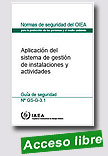 |
Aplicación del Sistema de Gestión de Instalaciones y Actividades
Colección de normas de seguridad del OIEA, 2016, 119 p.
El objetivo de esta publicación es dar directrices de carácter general para establecer, aplicar, evaluar y mejorar constantemente un sistema de gestión que
integre elementos de seguridad tecnológica, de salud, ambientales, de seguridad física, relativos a la calidad y económicos, con objeto de cumplir los requisitos
establecidos en la publicación Sistema de gestión de .
|
instalaciones y actividades, Colección de Normas de Seguridad del OIEA. La presente guía de seguridad también da ejemplos que ilustran la aplicación de los requisitos relativos al sistema de gestión
Extraído de: http://www-pub.iaea.org/MTCD/Publications/PDF/P1253S_web.pdf
|
 |
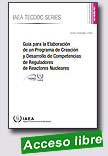 |
Guía para la Elaboración de un Programa de Creación y Desarrollo de Competencias de Reguladores de Reactores Nucleares
IAEA TECDOC, 2016, 144 p.
La “Guía para la Elaboración de un Programa de Creación y Desarrollo de Competencias de Reguladores de Reactores Nucleares” se propone presentar los lineamientos de un programa para el fortalecimiento de las competencias reguladoras, fundado en la experiencia operativa de los países con desarrollo nuclear que integran el FORO, y . |
diseñado de manera tal que maximiza el empleo de recursos propios de la región iberoamericana.
La Guía aporta elementos concretos que pretenden constituir ayudas para el desarrollo de aspectos específicos de dicho programa que se consideran de interés especial. Dichos elementos de ayuda están basados en los análisis y ejercicios desarrollados en el ámbito del proyecto CReAN y en un conjunto de buenas prácticas identificadas en diferentes países. Pueden tomarse, de forma completa o parcial, como orientaciones prácticas o como ejemplos ilustrativos.
Se espera, por tanto, que las recomendaciones recopiladas en esta Guía puedan ser utilizadas en mayor o menor medida por los órganos reguladores de los países del FORO (Argentina, Brasil, Chile, Colombia, Cuba, España, México, Perú y Uruguay), por otros organismos de la región iberoamericana o por cualquier otro país en el desarrollo de su programa nacional. La aplicabilidad en cada país será variable, en función de la naturaleza y alcance de su programa nuclear y del grado de implantación y desarrollo de estrategias nacionales para la creación y gestión de competencias reguladoras previamente establecidas
Extraído de: http://www-pub.iaea.org/MTCD/Publications/PDF/TE-1794_S_web.pdf
|
 |
|
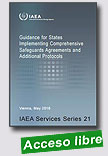
|
Guidance for States Implementing Comprehensive Safeguards Agreements and Additional Protocols
IAEA Services Series, 2016, 102 p.
This publication is aimed at enhancing States’ understanding of the safeguards obligations of both the State and the IAEA, and at improving the cooperation between States and the IAEA in safeguards implementation. It is principally intended for State or regional safeguards regulatory authorities and facility operators, and is a reference document that is supported by detailed guidance and examples in safeguards
|
implementation practices presented in other publications in the series. (This version is the 2016 update.)
Extraído de:
http://www-pub.iaea.org/books/IAEABooks/8842/Guidance-for
-States-Implementing-Comprehensive-Safeguards-
Agreements-and-Additional-Protoc
|
 |
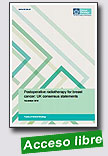 |
Postoperative radiotherapy for breast cancer: UK consensus statements
Royal College of Radiologists (UK), 2016, 27 p.
The Postoperative radiotherapy for breast cancer: UK consensus statements were developed by members of the oncology community, including professional groups, comissioners and patients. They state the expected standard for breast radiotherapy across the UK, covering cardiac sparing, breast boost radiotherapy, safe omission of radiotherapy, internal mammary chain (IMC) radiotherapy,
|
hypofractionation, axillary management of sentinel lymph node-positive disease and partial breast radiotherapy.
This is an opportunity to clearly state the expected standard for breast radiotherapy across the UK to make sure that patients receive equal treatment regardless of postcode.
The document includes the consensus statements aldongside details of the process and evidence used to reach them.
Extraído de: https://www.rcr.ac.uk/publication/postoperative-radiotherapy-breast-cancer-uk-consensus-statements
|
 |
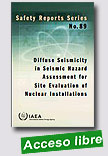 |
Diffuse Seismicity in Seismic Hazard Assessment for Site Evaluation of Nuclear Installations
IAEA Safety Reports Series, 2016, 88 p.
Diffuse seismicity refers to earthquakes occurring in locations where no apparent correlation can be made with any causative faults. The possibility of such earthquakes must be taken into consideration for nuclear installation sites, even for low to moderate seismicity regions, and their potential influence has to be assessed appropriately. This publication provides guidance for addressing the seismic hazard from diffuse .
|
|
 |
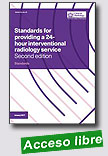 |
Standards for providing a 24-hour interventional radiology service, second edition
Royal College of Radiologists (UK), 2017, 16 p.
For the safety of patients, it is necessary that acute hospital trusts have formal and robust arrangements to ensure provision of emergency services 24 hours a day, every day of the year – interventional radiology is no exception. This publication encourages trusts to:
put patient safety first, recognising the essential role of interventional radiology; recognise the resources required to
|
provide an interventional radiology service; be clear and transparent about local arrangements for the provision of interventional radiology; decide what can and can’t be provided both in and out of hours; make arrangements which ensure robust and coherent regional interventional radiology service provision.
Extraído de: https://www.rcr.ac.uk/publication/standards-providing-24-hour-interventional-radiology-service-second-edition
|
 |
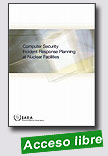 |
Computer Security Incident Response Planning at Nuclear Facilities
IAEA Non-serial Publications, 2016, 62 p.
The purpose of this publication is to assist Member States in developing comprehensive response plans for computer security incidents with the potential to adversely impact nuclear security and/or nuclear safety.
This publication supplements the existing literature by addressing the unique nature of nuclear and other radioactive material facilities and the unique security requirements |
associated with nuclear and other radioactive material. It provides guidance on the key elements for developing and implementing a comprehensive response to a computer security incident (i.e. cyber-attack) that may compromise or adversely impact nuclear security. It covers: Characterizing computer security incidents; Defining response policy, roles and responsibilities; Implementing the computer security incident response plan.
Extraído de:http://www-pub.iaea.org/books/IAEABooks/10998/
Computer-Security-Incident-Response-Planning-
at-Nuclear-Facilities
|
 |
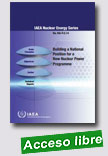 |
Building a National Position for a New Nuclear Power Programme
IAEA Nuclear Energy Series, 2016, 19 p.
This publication provides guidance to countries seeking to establish a national position on the introduction or re-establishment of a nuclear power programme. It provides direction to political decision makers, energy experts, and other stakeholders about the process for establishing a national position as countries prepare national nuclear energy
|
policies. It also helps embarking countries to build a consistent and durable national position for nuclear power on the basis of sound energy planning and greater public involvement in order to maintain the country’s long term commitment, regardless of possible political changes in a country.
Extraído de: http://www-pub.iaea.org/books/IAEABooks/10954/Building-a-National-Position-for-a-New-Nuclear-Power-Programme
|
 |
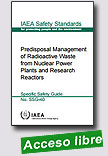 |
Predisposal Management of Radioactive Waste from Nuclear Power Plants and Research Reactors - Specific Safety Guide
IAEA Safety Standards, 2016, 83 p.
This Safety Guide provides operating organizations that generate and manage radioactive waste as well as regulatory bodies and government bodies with recommendations on how to meet the requirements for the predisposal management of radioactive waste generated at nuclear power plants and research reactors (including subcritical and critical |
assemblies). It covers all stages in the lifetime of waste management facilities, including their siting, design, construction, commissioning, operation, and shutdown and decommissioning. It covers all steps carried out in the management of radioactive waste following its generation up to (but not including) disposal, including its processing (pre-treatment, treatment and conditioning). Radioactive waste generated during normal operation and in accident conditions is considered.
Extraído de: http://www-pub.iaea.org/books/IAEABooks/10923/Predisposal-Management-of-Radioactive-Waste-from-Nuclear-Power-Plants-and-Research-Reactor
|
 |
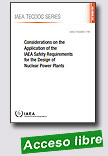 |
Considerations on the Application of the IAEA Safety Requirements for the Design of Nuclear Power Plants
IAEA TECDOC, 2016, 88 p.
The main purpose of this publication is to provide insights and approaches in support of the practical application of the new crucial requirements introduced in SSR-2/1 [1] and subsequently reinforced in SSR-2/1 [1]. The TECDOC also identifies some terms that need to be explained consistent with the requirements.
|
The IAEA Secretariat expects that the effort devoted to the preparation of this publication will also facilitate and harmonize the preparation/revision of supporting Safety Guides for design and safety assessment of NPPs that are related to SSR-2/1 [1]. This publication could also be used as the basis for a future Safety Guide.
Extraído de: http://www-pub.iaea.org/books/IAEABooks/10998/Computer-Security-Incident-Response-Planning-at-Nuclear-Facilities
|
 |
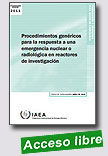 |
Procedimientos genéricos para la respuesta a una emergencia nuclear o radiológica en reactores de investigación
OIEA, Abril de 2016, 200 p.
Los objetivos de esta publicación son: Describir las respuestas apropiadas ante diversos tipos de emergencias en emplazamientos de reactores de investigación de las categorías de amenaza II y III; Describir la organización que se precisa en el emplazamiento para responder a esas |
emergencias; Proporcionar herramientas para organizar las medidas de la respuesta a las emergencias en esos emplazamientos de reactores; Proporcionar procedimientos para determinar la necesidad de medidas protectoras en el emplazamiento y fuera de él.
Extraído de: http://www-pub.iaea.org/MTCD/Publications/PDF/EPR-Research%20Reactor%202011_s_web.pdf
|
|
